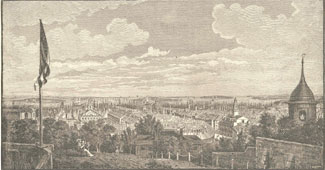Pemberton Square
Pemberton Square was once Cotton Hill, which had its summit removed about the same time as that of Beacon Hill. It was the third hill of the "Tri-Mountain" or "Tremont," of early Boston along with other peaks of Beacon Hill, where the State House now is, and West Hill or Mt. Vernon, roughly where Louisburg Square now is. It was the home of Reverend John Cotton, minister of the First Church of Boston, and for whom the Hill was originally named. The hill was also the location of the homes of the stern old Puritan Governor John Endecott and twenty-three year old Governor Sir Henry Vane, and was also the birthplace of Elihu Yale, the benefactor of the University in New Haven. [1]

In the 1700s, the renamed Pemberton Hill was the site of the grand estates of the Faneuil and Phillips families. These estates boasted large houses with formal gardens. The Hill retained something of its earlier, detached quality, which is clearly shown in the large painting View of Boston from Pemberton Hill, done by the artist Robert Salmon in 1816-1829. It shows a pleasant vista of rooftops and the Harbor beyond, disrupted only by the graceful cupolas of the Old State House, Faneuil Hall and Phillips Mansion in the foreground.
Changes came to the Hill within a few decades. The top of the Hill was reduced by sixty-five feet around 1835. Where once was the crest of the Hill, a new residential square, similar in nature to that of Louisburg Square on the other side of Beacon Hill, was created. The Square was lined with residential brownstones and had a quiet gentile atmosphere. Restrictions on building heights and materials created an area of "uniform and harmonious architectural treatment," in the words of Walter Muir Whitehill.[2] The residences soon gave way to offices spilling over from the nearby bustling Scollay Square. The artist Cyrus Dallin, best known for his equestrian statute of Paul Revere in the North End, had his studio here, but in 1883, he had to move. The City of Boston had chosen the western side of the square as the location for a new courthouse.
Within a few years, the transformation of the Square was well underway. Frank Mason, writing in The Christian Science Journal in December of 1887 thoughtfully considered the "Extensive alterations [which] are being made in Pemberton Square, Boston, with the view to erecting a courthouse, where justice may reign supreme. Old buildings and trees have been removed…."[3] The "massive" new building, the adjective most often applied to it, was soon "plumped down in the region, obliterating all sense of proportion," according to Whitehill. [4]
When the courthouse was finished in 1894 it attracted more professionals to the Square, mostly attorneys who set up their offices there. It also attracted the Boston Police Department, which moved its headquarters to 37 Pemberton Square in 1883, where it remained until 1925. The addition of the "New" Court House in 1939 hastened the changes to the Square as part of the "Old" Court House was demolished to make way for the addition. The final vestiges of the old residential square were swept away with the urban renewal programs of the 1950s and 1960s. The old brownstones and buildings of Pemberton Square, Dock Square and Scollay Square were torn down and replaced with the concrete and brick expanse of Government Center. The view of the Court House complex in old Pemberton Square was allowed to be completely obscured, quite possibly because it didn't conform to the ideals of the Government Center planners.[5]
Footnotes:
[1]See generally JOHN HARRIS, HISTORIC WALKS IN OLD BOSTON 79-83 (3rd ed. 1993).
[2]WALTER MUIR WHITEHILL, BOSTON: A TOPOGRAPHICAL HISTORY 110 (3rd ed. 2000).
[3] Frank Mason, Herod and the Star, THE CHRISTIAN SCIENCE JOURNAL, December 1887.
[4] WHITEHILL, supra note 2.
[5] Id., at 244.